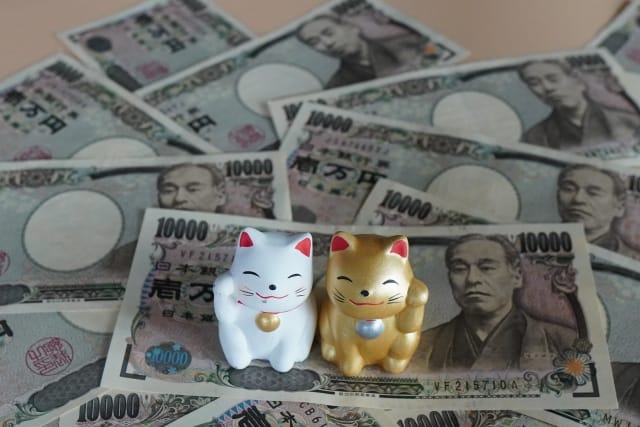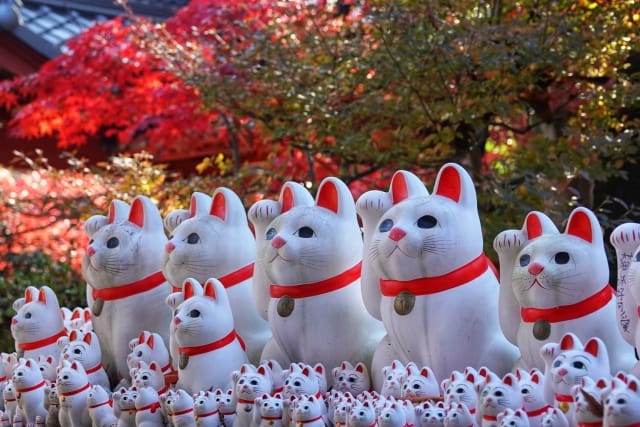Maneki-Neko: A Cultural Icon in Japanese Tradition

Maneki Neko, commonly recognized as a part of Japanese culture, is a small figurine usually made from ceramics or porcelain. Characterized by its smiling appearance and a raised front paw, its origin is not definitively known but is believed to have emerged in the late Edo period. The earliest recorded instance is seen in Utagawa Hiroshige’s 1852 ukiyo-e woodblock print “Joruri-machi Hanka no zu,” depicting “Marushime-neko,” a form of Maneki Neko, being sold at Senso-ji Temple in Tokyo.
Various legends surround Maneki Neko, the most famous being related to the late Edo period’s Gotokuji Temple. According to this legend, a cat saved a samurai from a thunderstorm, leading to the temple’s prosperity under the samurai’s patronage. Following the cat’s death, a statue was erected in its honor, and many Maneki Neko statues are offered at the temple to this day.
Maneki Neko can be found with either its right or left paw raised. The left paw is believed to attract customers, while the right paw is thought to bring good fortune and wealth. The colors of Maneki Neko also carry various meanings: white symbolizes happiness and purity, black protects from evil spirits, red guards against illness, gold signifies wealth, pink represents love and romance, blue denotes academic success, and green indicates family protection.
The Meaning of Maneki Neko
Maneki Neko, a traditional Japanese figurine, is believed to bring business prosperity and good fortune. Its distinctive pose, color, and symbolic meanings reflect the deep history and beliefs in Japanese culture.
Differences in Meaning Between the Raised Right and Left Paws

- Maneki Neko with Raised Right Paw
- A Maneki Neko with its right paw raised is said to bring financial prosperity and wealth.
- This is commonly seen in businesses and enterprises seeking monetary success and abundance.
- Maneki Neko with Raised Left Paw
- A Maneki Neko raising its left paw is believed to attract customers and people.
- It is often placed in stores and businesses to draw in clientele and enhance business prosperity.
Significance of Different Colors
- White
- A white Maneki Neko symbolizes happiness and purity.
- It is generally associated with bringing pure good fortune.
- Black
- A black Maneki Neko signifies protection from evil spirits.
- It is often used for safeguarding health and safety.
- Red
- A red Maneki Neko represents protection from illness.
- It embodies the wishes for good health and longevity.
- Gold
- A gold Maneki Neko indicates an improvement in financial fortune.
- It is believed to bring wealth and prosperity.
- Pink
- Pink Maneki Neko symbolizes love and romance.
- It is chosen to enhance romantic luck and relationships.
- Blue
- A blue Maneki Neko means success in academics and knowledge.
- It is popular among students and scholars.
- Green
- Green Maneki Neko is associated with the health and safety of the family.
- It is favored for bringing harmony and peace within the household.
Types of Maneki Neko
Maneki Neko, a traditional Japanese figurine believed to bring business prosperity and wealth, has its roots in the Edo period. These cats are made from various materials and exhibit regional stylistic differences. Commonly seen in stores and restaurants, they are believed to contribute to prosperity and financial luck.
Additionally, Maneki Neko may carry various items like collars, bells, lucky fish, gems, or radishes, each symbolizing specific fortunes.
Modern Styles
Recently, the popularity of Maneki Neko has led to the emergence of modern versions made from plastic or electronic components. These are used as decorative items in homes and businesses or given as gifts to celebrate new openings or business ventures.
Regional Variations
The style and meaning of Maneki Neko can vary depending on its origin and associated legends. For example, the legend associated with Gotokuji Temple, where a Maneki Neko reportedly saved a wealthy lord from a thunderstorm, has led to many Maneki Nekos being offered at this temple.
Summary
Maneki Neko, with its endearing appearance and symbolism of good fortune, enjoys popularity both in Japan and abroad. From traditional ceramic versions to modern plastic and electronic forms, they come in various styles, each imbued with unique meanings and symbols. This diversity and the regional characteristics of Maneki Neko can be explored in detail to convey their charm and appeal to readers.
The Modern Role of Maneki Neko
In contemporary Japan, Maneki Neko is widely used in commercial establishments and stores. Specifically, a Maneki Neko with its left paw raised is believed to invite customers, while one with its right paw raised is thought to bring financial prosperity and wealth. These cat figurines can be found in various places, from the entrances of restaurants and shops to the dashboards of taxis, spreading good fortune.

International Acceptance of Maneki Neko as a Cultural Symbol
Maneki Neko is recognized globally as a symbol of Japanese culture and has gained popularity worldwide. Its appeal extends beyond traditional meanings, influencing pop culture and contemporary art. For example, during the “Cool Japan” movement of the 1980s and 1990s, Maneki Neko became internationally renowned, even being incorporated into pop culture phenomena like the Pokémon character Meowth.
Diversity in Modern Styles
Maneki Neko continues to be enjoyed in various sizes and styles in modern times. From traditional ceramic versions to modern plastic and electronic models with moving parts, they appeal to collectors and enthusiasts alike, adding an interactive element to this charming figurine.
Use in Commercial Establishments
Maneki Neko is commonly seen in business settings, believed to attract customers and foster prosperity. They are often placed near entrances or cash registers, establishing their status as symbols of good luck.
Exploring the Charm of Karaoke Maneki neko: Japan’s Beloved Karaoke Chain

Karaoke Manekineko is a popular karaoke chain that spans across Japan. Known for its affordable pricing and a wide range of musical selections, it is especially popular among young people and students, serving as a go-to spot for fun times with friends and family. The interior of Manekineko is bright and casual, creating an environment where guests can relax and enjoy singing.
Additionally, the chain offers an extensive menu of food and drinks, allowing patrons to indulge in various cuisines and beverages while singing. Some locations feature special themed rooms and state-of-the-art sound systems, enhancing the karaoke experience. As a symbol of Japan’s karaoke culture, Karaoke Manekineko continues to be cherished by many.
Summary
Maneki Neko, with its attractive appearance and symbolism of bringing good fortune, remains a beloved entity both in and outside of Japan. While retaining its traditional significance, it has also established a position as a modern cultural and international symbol, appealing to a wide audience.
In Conclusion
Maneki Neko, known for its appearance in the late Edo period in Japan, is shrouded in mystery and numerous legends. One such legend tells of a poor 17th-century monk living in the Gotokuji Temple with his bobtail cat. As the story goes, a lord seeking shelter from a storm was beckoned by the cat near the temple, saving him from a lightning strike. Grateful, the lord became a patron of the temple, and after the cat’s demise, a Maneki Neko statue was created in its honor.
In modern Japanese culture, Maneki Neko plays a significant role. Commonly seen in commercial settings like shops and restaurants, these cats are believed to attract customers and bring financial prosperity. The different poses and colors of Maneki Neko symbolize various types of luck.
For instance, a cat with its right paw raised is thought to bring financial fortune, while the left paw raised is believed to attract customers. Moreover, the colors hold specific meanings: white symbolizes purity and good fortune, black protects from evil spirits, gold signifies wealth, red for health, blue for academic or work success, and green for family safety.
Maneki Neko continues to be an endearing symbol in and outside of Japan, merging traditional meanings with modern culture and international symbolism. These charming cats, recognized as symbols of Japanese culture, represent good fortune and prosperity, capturing the hearts of many worldwide.
This information on Maneki Neko offers a glimpse into a facet of Japanese culture, providing an opportunity to understand its cultural value and impact from a fresh perspective.

